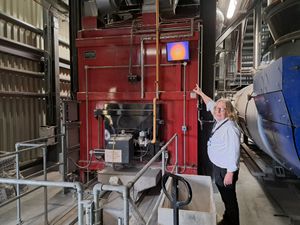How an incinerator the size of a bus saves Wolverhampton hospital £200,000 a year
It’s the size of a double-decker bus and incinerates 38 tonnes of waste a week which heats a hospital and saves £200,000 a year.

The incinerator at Wolverhampton's New Cross Hospital certainly earns its keep.
It burns all clinical waste – anything medical or that has come into contact with a patient.
All hazardous and clinical waste generated by The Royal Wolverhampton NHS Hospital Trust is incinerated and the steam produced is used to heat the site.
Items include personal protective equipment (PPE), sharps, single-use surgical instruments and leftover pharmaceuticals.
Located at the energy centre near the chimney at the northern end of the site, the current incinerator has been used for more than two years.
The first one, built in 1992, lasted 27 years.
Known as a ‘heat from waste’ plant, the steel-made machine with a refractory lining to provide high-temperature resistance burns up to 350kg of waste an hour, reaching temperatures in excess of 1,100C.
A team of eight staff, led by John Burrows, energy centre and decontamination manager, works full-time on shifts to ensure the incinerator is operating 24 hours a day, six days a week.
In the summer, it can provide heat for virtually the entire hospital site, combined with a massive generator producing two megawatts of electricity.
From that, high-grade heat is generated which produces steam from the exhaust and low-grade heat from the coolants, or radiator section of the engine.
“We’re now incinerating about 34 tonnes (the other four tonnes comes from third parties) of waste a week, which has increased from 20 tonnes over the last five or six years,” said John.
“We use the excess heat from incinerating the waste to generate steam for the site that in turn is used to generate heating, hot water and sterilisation for various uses. It’s like your boiler at home but we generate steam to transport energy around the site instead of hot water as it can contain more energy.
“It sounds strange to say but we use heat even at the height of the summer, for domestic hot water and ventilation plants, for example.”
Using heat and dust in such vast quantities requires significant maintenance and the plant shuts down for about three weeks annually.
“It’s like running a Jeep through the desert in ridiculous temperatures – there’s always something going on to maintain it,” added John.
“We save £200,000 in gas a year by using the incinerator, but there are operational costs in running it and gas we have to pay for.
“But that can be offset by income from third parties, and we take on about 20 per cent of out-sourced waste, such as Wolverhampton Council. It’s certainly a lot cheaper than us exporting our waste.
“Cleaning the boiler every week takes 18-20 hours. But we have another boiler that runs in tandem so we can always run one while the other is cleaned.”
As for the process, yellow bins around the site are collected into one 1,100-litre bin and then Richard Penberthy, waste manager, arranges for that to be picked up.
“We then have an allotted time to get rid of it,” said John.
“It’s weighed, audited where it’s come from and loaded into five bins, then placed on a conveyor and lifted into an elevator before entering the incinerator.
“It’s a continuous process. We add a bit of gas to warm it up, then we burn the waste and burn the gases given off from the waste, but then we have to cool them down.
“This is where we make big savings because all the site’s steam servicing the heating is fed from the energy centre which the incinerator is the line.
“We get the energy back in the form of heat – we run the hot gas through the boiler and we generate steam from that which in effect goes to the rest of the site.”
The cooled gases used are treated with sodium bicarbonate to neutralise them to achieve compliance so they can exit the chimney, while a massive filter plant removes all particles and chemicals. Any surviving ash is disposed in a skip which is buried in deep landfill.
Since September 2021, a further £50,000 has been saved by burning waste transported from Cannock Chase Hospital.
Janet Smith, head of sustainability at RWT, said: “The incinerator is one of the remaining five incinerators in England operated by an NHS trust.
“On top of providing safe disposal of clinical waste, it is also a vital part of the trust energy security strategy to generate low-carbon source of energy.
“This includes onsite electricity generation via solar pv, (which converts sunlight into electrical energy) and contributes to the reduction of the trust’s carbon emissions and dependence on imported oil and gas.”
The incinerator is subject to the conditions of Wolverhampton Council’s permit of continuous emission monitoring, which means it has to undergo annual emissions surveillance tests.





